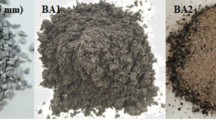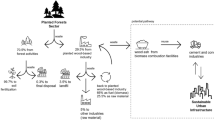Abstract
Biomass ash has been produced worldwide in large quantities and has often generated high storage costs or environmental problems. A valorisation alternative, regarding this waste, has been its use in mortar or concrete; however, as biomass ashes exhibit larger variations in physico-chemical characteristics, which depend on the type of biomass fired, combustion methods used and type of ash collected, proper knowledge of its properties is required before using it as an aggregate or mineral additive. In this study, the biomass bottom ash (BBA) and biomass fly ash (BFA) generated in the cocoa industry, by the burning of wood chips and cocoa shell waste, are characterized to evaluate their potential use as partial cement replacements. In addition, nine types of concrete were produced with 0, 5 and 10% of cement (by mass) replaced by BBA and BFA, as received and ground. For these mixtures, physical and mechanical tests were performed. For all levels of cement replacement, the ash reduced water absorption, porosity and capillary indexes, which can make the concrete more durable, despite reducing mechanical strength. The mechanical strength evaluation of concrete samples subjected to compressive loading cycles after 365 days, demonstrated that the addition of ash does not have any long-term deleterious effect on the concrete.











Similar content being viewed by others
References
Vassilev, S.V., Baxter, D., Andersen, L.K., Vassileva, C.G.: An overview of the chemical composition of biomass. Fuel 89, 913–933 (2010)
Werther J., Saenger M., Hartge E.U., Ogada T., Siagi Z.: Combustion of agricultural residues. Prog. Energy Combust. Sci. 26, 1–27 (2000)
ICCO: International Cocoa Organizaton: Quarterly Bulletin of Cocoa Statistics: cocoa year 2013/14, Vol. XL, No. 4. http://www.icco.org/about-us/international-cocoa-agreements/doc_download/240-production-latest-figures-from-the-quarterly-bulletin-of-cocoa-statistics.html (2014). Accessed 01 May 2014
Osundahunsi, O.F., Bolade, M.K., Akinbinu, A.A.: Effect of cocoa shell ash as an alkalizing agent on cocoa products. J. Appl. Sci. 7, 1674–1678 (2007)
Spilacek, M., Lisy, M., Balas M., Skala, Z. The comparison of wood chips and cocoa shells combustion. In: International Conference on Energy, Environment, pp. 217–220. (2014)
Silva, R.B.: Characterization of biomass ash generated in the agroindustries of cocoa and its use as mineral addition in concrete. Thesis (Master of Civil and Environmental Engineering). PPGECEA/UEFS. Feira de Santana, (2013). (In Portuguese).
Vassilev, S.V., Baxter, D., Andersen, L.K., Vassileva, C.G.: An overview of the composition and application of biomass ash.: part 2. Potential utilization, technological and ecological advantages and challenges. Fuel 105, 19–39 (2013)
Carrasco, B., Cruz, N., Terrados, J., Corpas, F.A., Pérez, L.: An evaluation of bottom ash from plant biomass as a replacement for cement in building blocks. Fuel 118, 272–280 (2014)
Ban, C.C., Ramli, M.: The implementation of wood waste ash as a partial cement replacement material in the production of structural grade concrete and mortar: an overview. Resour. Conserv. Recyl. 55, 669–685 (2011)
Wang, S., Miller, A., Llamazos, E., Fonseca, F., Baxter, L.: Biomass fly ash in concrete: mixture proportioning and mechanical properties. Fuel 87, 365–371 (2008)
Hinojosa, M.J.R., Galvín, A.P., Agrela, F., Perianes, M., Barbudo, A.: Potential use of biomass bottom ash as alternative construction material: Conflictive chemical parameters according to technical regulations. Fuel 128, 248–259 (2014)
Roessler, J., Paris, J., Ferraro, C.C., Watts, B., Townsend, T.: Use of waste to energy bottom ash as an aggregate in Portland cement concrete: impacts of size fractionation and carbonation. Waste Biomass Valoriz. 7, 1521–1530 (2016)
Modolo, R.C.E., Silva, T., Senff, L., Tarelho, L.A.C., Labrincha, J.A., Ferreira, V.M., Silva, L.: Bottom ash from biomass combustion in BFB and its use in adhesive-mortars. Fuel Process. Technol. 129, 192–202 (2015)
ASTM C 618: Standard specification for coal fly ash and raw or calcined natural pozzolan for use as a mineral admixture for concrete. Annual book of ASTM standards. American Standard Test Method, Philadelphia (2012)
British Standards Institution, BS EN 450-1: Fly ash for concrete: definitions, specifications and conformity criteria. BSI, London (2012)
Cordeiro, G.C., Toledo Filho, R.D., Fairbairn, E.M.R.: Use of ultrafine rice husk ash with high-carbon content as pozzolan in high performance concrete. Mater. Struct. 42, 983–992 (2009)
Vassilev, S.V., Baxter, D., Andersen, L.K., Vassileva, C.G.: An overview of the composition and application of biomass ash. Part 1. Phase–mineral and chemical composition and classification. Fuel 105, 40–76 (2013)
Berra, M., Mangialardi, T., Paolini, A.: Reuse of woody biomass fly ash in cement-based materials. Constr. Build. Mater. 76, 286–296 (2015)
Cuenca, J., Rodríguez, J., Martín-Morales, M., Sánchez-Roldán, Z., Zamorano, M.: Effects of olive residue biomass fly ash as filler in self-compacting concrete. Constr. Build. Mater. 40, 702–709 (2013)
Rosales, J., Beltrán, M.G., Cabrera, M., Velasco, A., Agrela, F.: Feasible use of biomass bottom ash as addition in the manufacture of lightweight recycled concrete. Waste Biomass Valoriz. 7, 953–963 (2016)
Chowdhury, S., Mishra, M., Suganya, O.: The incorporation of wood waste ash as a partial cement replacement material for making structural grade concrete: an overview. Ain Shams Eng. J. 6, 429–437 (2015)
Naik, T.R., Kraus, R.N., Siddique, R.: Demonstration of manufacturing technology for concrete and CLSM utilizing wood ash from Wisconsin. UWM Centre for By Product Utilization, Milwaukee (2002)
Elinwa, A.U., Mahmood, Y.A.: Ash from timber waste as cement replacement material. Cem. Concr. Compos. 24, 219–222 (2002)
Kalembkiewicz, J., Chmielarz, U.: Ashes from co-combustion of coal and biomass: new industrial wastes. Resour. Conserv. Recycl. 69, 109–121 (2012)
ABNT—Brazilian Association of Technical Standards. NBR NM 23: Portland cement and other powdered material—determination of density. ABNT—Brazilian Association of Technical Standards, Rio de Janeiro, p. 5 (2000) (In Portuguese)
ABNT—Brazilian Association of Technical Standards. NBR NM 248: Aggregates—sieve analysis of fine and coarse aggregates. ABNT—Brazilian Association of Technical Standards, Rio de Janeiro, p. 5 (2003) (In Portuguese).
ABNT—Brazilian Association of Technical Standards. NBR NM 46: Aggregates—determination of material finer than 75 µm sieve by washing. ABNT—Brazilian Association of Technical Standards, Rio de Janeiro, p. 6 (2003) (In Portuguese)
ABNT—Brazilian Association of Technical Standards. NBR NM 52: Fine aggregate—determination of the bulk specific gravity and apparent specific gravity. ABNT—Brazilian Association of Technical Standards, Rio de Janeiro, p. 6 (2003) (In Portuguese)
ABNT—Brazilian Association of Technical Standards. NBR NM 53: Coarse aggregate—determination of the bulk specific gravity, apparent specific gravity and water absorption. ABNT—Brazilian Association of Technical Standards, Rio de Janeiro, p. 8 (2003) (In Portuguese)
ABNT—Brazilian Association of Technical Standards. NBR NM 30: Fine aggregate—test method for water absorption. ABNT—Brazilian Association of Technical Standards, Rio de Janeiro, p. 3 (2003) (In Portuguese)
ASTM—American Society for Testing and Materials. C642: Standard test method for density, absorption, and voids in hardened concrete. ASTM International, West Conshohocken (2006) doi:10.1520/C0642-06, http://www.astm.org
ABNT—Brazilian Association of Technical Standards. NBR 5739: Concrete—compression test of cylindric specimens—method of test. ABNT—Brazilian Association of Technical Standards, Rio de Janeiro, p. 9 (2007) (In Portuguese)
ABNT—Brazilian Association of Technical Standards. NBR 7222: Mortar and concrete—determination of the tension strength of cylindrical specimens submitted to diametrical compression—method of test. ABNT—Brazilian Association of Technical Standards, Rio de Janeiro, p. 3 (1994) (In Portuguese)
ABNT—Brazilian Association of Technical Standards. NBR 9779: Mortar and hardened concrete—determination of water absorption by capillarity. ABNT—Brazilian Association of Technical Standards, Rio de Janeiro, p. 3 (2012) (In Portuguese)
Alexpoulos, D., Itskos, G., Vasilatos, C., Koukouzas, N., Stamatakism, M.: Mine wastewater tretament by highly calcareous and siliceous fly ash: a comparative study. In: World of coal ash (WOCA) conference. (2013).
Demisa, S., Tapalib, J.G., Papadakis, V.G.: An investigation of the effectiveness of the utilization of biomass ashes as pozzolanic materials. Constr. Build. Mater. 68, 291–300 (2014)
Abraham, R., George, J., Thomas, J., Yusuff, K.K.M.: Physicochemical characterization and possible applications of the waste biomass ash from oleoresin industries of India. Fuel 109, 366–372 (2013)
Umamaheswaran, K., Batra, V.S.: Physico-chemical characterisation of Indian biomass ashes. Fuel 87, 628–638 (2008)
Tay, J.H.: Ash from oil-palm waste as concrete material. J. Mater. Civ. Eng. 2, 94–105 (1990)
Hall, C., Yau, M.H.R.: Water movement in porous building materials—IX. The water absorption and sorptivity of concretes. Build. Environ. 22, 77–82 (1987)
Tangchirapat, W., Buranasing, R., Jaturapitakkul, C.: Use of high fineness of fly ash to improve properties of recycled aggregate concrete. J. Mater. Civ. Eng. 22, 565–571 (2010)
Pitroda, J., Umrigar, F.S., Principal, B.V.M., Anand, G.I.: Evaluation of sorptivity and water absorption of concrete with partial replacement of cement by thermal industry waste (fly ash). Int. J. Eng. Innov. Technol. 2, 245–249 (2013)
Erdoğdu, K., Türker, P.: Effects of fly ash particle size on strength of portland cement fly ash mortars. Cem. Concr. Res. 28, 1217–1222 (1998)
Chrisp, T.M., Wood, J.G.M., Norris, P.: Towards quantification of microstructural damage in AAR deteriorated concrete. In Shah S.P., Swartz S.E., Barr B. (eds.) Proceedings of the International Conference on Recent Developments on the Fracture of Concrete and Rocks, Cardiff, Wales, 20–22 Sept. 1989, pp. 419–427, Elsevier Applied Science, London (1989)
Nadeem, A., Memon, S.A., Lo, T.Y.: Evaluation of fly ash and metakaolin concrete at elevated temperatures through stiffness damage test. Constr. Build. Mater. 38, 1058–1065 (2013)
Sanchez, L.F.M., Fournier B., Jolin M., Bastien J.: Evaluation of the stiffness damage test (SDT) as a tool for assessing damage in concrete due to ASR: test loading and output responses for concretes incorporating fine or coarse reactive aggregates. Cem. Concr. Res. 56, 213–229 (2014)
Vonk R.A.: A micromechanical investigation of softening of concrete loaded in compression. Heron 38, 3–94 (1993)
Maschio, S., Tonello, G., Piani, L., Furlani, E.: Fly and bottom ashes from biomass combustion as cement replacing components in mortar production: rheological behaviour of the pastes and materials compression strength. Chemosphere 85, 666–671 (2011)
Garcia, M.L., Coutinho, J.S.: Strength and durability of cement with forest waste bottom ash. Constr. Build. Mater. 41, 897–910 (2013)
Funding
Funding was provided by FAPESB (Grant No: PET 0010/2012).
Author information
Authors and Affiliations
Corresponding author
Rights and permissions
About this article
Cite this article
Fontes, C.M.A., Silva, R.B. & Lima, P.R.L. Characterization and Effect of Using Bottom and Fly Ashes from Co-combustion of Cocoa Waste as Mineral Addition in Concrete. Waste Biomass Valor 10, 223–233 (2019). https://doi.org/10.1007/s12649-017-0031-x
Received:
Accepted:
Published:
Issue Date:
DOI: https://doi.org/10.1007/s12649-017-0031-x




